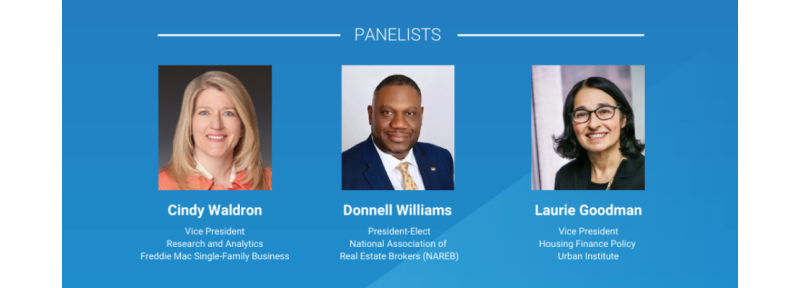What Can be Done Today to Expand Homeownership in Underserved Communities Despite Covid-19

Freddie Mac
Increasing homeownership in underserved communities is one of the biggest challenges confronting the mortgage industry.
Among other barriers, COVID-19 and the current recession triggered by the pandemic has made homeownership in these areas more difficult. Moreover, builders are likely to not be ramping up new affordable construction anytime soon, leaving a lack of supply as the biggest, overarching impediment.
However, there are things that can still be done today to advance homeownership in underserved communities, particularly in African American neighborhoods, according to a recent HousingWire panel discussion.

Three Key Considerations to Increase Homeownership
While the HousingWire panelists discussed a range of issues surrounding homeownership in underserved communities, three key issues/considerations include:
1. Establishing the possibility of homeownership
Greater investment into borrower education and counseling is something lenders can do immediately to advance homeownership in underserved communities, said Laurie Goodman of the Urban Institute. This should be done with an eye towards overcoming the down payment obstacle and raising the baseline level of knowledge about mortgage financing.
“Many borrowers don’t know you can buy a home [by putting] only 3% or 3.5% down,” Goodman pointed out. “Black and Hispanic borrowers are often times less familiar with the process because they’re less apt to have others in their family who have bought a home.”
Residents in these communities often lack family wealth they can tap into for help with a down payment or earn too little to save for one, Goodman said. More so than other groups, minority residents often lack anecdotal knowledge about mortgages on top of having limited financial resources. This adds another layer of necessary education prior to helping them navigate down payment assistance programs or mortgages requiring only 3% down.
“There are over 3,000 different [down payment assistance] programs available in the United States, and borrowers can’t possibly be aware of all of them,” Goodman noted, “so lenders have to provide some guidance here.”
2. Providing more support through trusted advisors
An important priority today is to increase the number of trusted advisors to support individuals in underserved communities through the mortgage process, said Donnell Williams, president-elect of the National Association of Real Estate Brokers (NAREB), during the discussion. Myths discouraging borrowing, such as those that exist in African American communities, are based on decades of historic discrimination and persevere from one generation to the next. Ramping up education programs can help chip away at the pervasive skepticism about the affordability of mortgages.
Misconceptions about mortgages not only make residents more skeptical about their affordability, but they compound the difficulty of increasing awareness about mortgage products designed to be affordable to lower- to moderate-income borrowers.
“If you don’t know you’re able to put down 3% [as a down payment], or you’re not sure,” said Williams, “[these opportunities] are more likely dismissed as myths and rumors in the underserved community.”
3. Geographically targeted research needed to customize solutions
To truly understand barriers to homeownership in underserved communities, it’s critical to drill down to data at the local level per a specific geographic area, explained Cindy Waldron, vice president of research and analytics in Freddie Mac’s Single-Family division.
To do this, Waldron said her research team measured affordability for moderate-income individuals within a specific metropolitan area, or MSA, and created a first-time homebuyer (FTHB) affordability index. The index, based on area median income (AMI), shows insights not easily found with broader geographical research.
“For example, while at a higher level, the research concludes homeownership is more affordable in the Midwest and the South relative to the coastal regions,” Waldron said, “But with a deeper dive into the different [income] segments, we see the South becomes not as affordable for the low- to moderate-income (LMI) population within this space.”
Localized research makes it easier to identify the biggest barriers to homeownership, particularly for low-income and minority residents, for underserved communities located within one metro area, versus those in another MSA. It also helps to better measure comparatively the degree to which the biggest barriers impede progress within different metro areas, Waldron pointed out.
“We have to think about this more holistically and on a local level,” Waldron said. “We have to think borrower of the future – from the very beginning of the process over a lifetime of homeownership – to make it sustainable.”
While locality differentiates affordability problems across underserved communities, a lack of household wealth to sustaining homeownership is common to all of them. It requires thoughtful, sequential solutions—with education as the cornerstone—throughout the stages of homebuying and homeownership, versus just at one point in the journey.
“I don’t really think there are one or two main things you can say to focus on for the underserved community…,”Waldron added, “I’d say after having seen this research there are many key factors and you have to look across all of them,” Waldron said.
A clearer understanding of the problems rooted in a community inspire new ideas, solutions and ways to improve upon current strategies, said Waldron. She said better analysis can lead not only to more ideas but unite and invite more participation from industry players across the entire housing ecosystem.
Moving Ahead on Serving Underserved Communities Despite the Uncertainties
Increasing the level of homeownership in underserved communities requires localized research and varying solutions tied to specific geographic areas. There is recognition to this effect, industrywide and luckily no shortage of ideas in a bid for progress.
Subscription Center
Get and stay connected with Freddie Mac Single-Family. Subscribe to our emails and we'll send the information that you want straight to your email inbox.